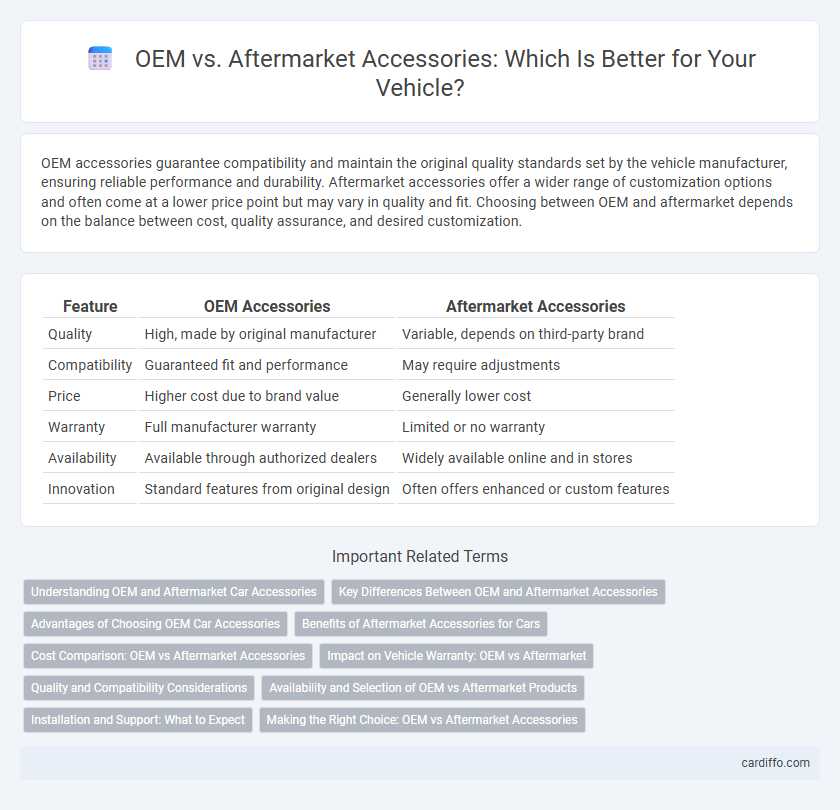OEM accessories guarantee compatibility and maintain the original quality standards set by the vehicle manufacturer, ensuring reliable performance and durability. Aftermarket accessories offer a wider range of customization options and often come at a lower price point but may vary in quality and fit. Choosing between OEM and aftermarket depends on the balance between cost, quality assurance, and desired customization.
Table of Comparison
| Feature | OEM Accessories | Aftermarket Accessories |
|---|---|---|
| Quality | High, made by original manufacturer | Variable, depends on third-party brand |
| Compatibility | Guaranteed fit and performance | May require adjustments |
| Price | Higher cost due to brand value | Generally lower cost |
| Warranty | Full manufacturer warranty | Limited or no warranty |
| Availability | Available through authorized dealers | Widely available online and in stores |
| Innovation | Standard features from original design | Often offers enhanced or custom features |
Understanding OEM and Aftermarket Car Accessories
OEM car accessories are manufactured by the original vehicle maker, ensuring perfect fit, compatibility, and adherence to factory specifications, which often translates to higher reliability and warranty coverage. Aftermarket accessories are produced by third-party companies and offer a wider variety of styles, features, and price points, but may vary in quality and compatibility with the vehicle. Understanding the differences between OEM and aftermarket accessories helps consumers make informed decisions based on factors like cost, performance, and vehicle value retention.
Key Differences Between OEM and Aftermarket Accessories
OEM accessories are manufactured by the original equipment maker, ensuring precise compatibility and adherence to manufacturer specifications for optimal performance and warranty preservation. Aftermarket accessories are produced by third-party companies, often offering a wider range of styles and potentially lower costs but with varying levels of quality and fit. Key differences include material quality, design compatibility, cost, warranty implications, and the potential impact on vehicle performance and resale value.
Advantages of Choosing OEM Car Accessories
OEM car accessories ensure perfect compatibility and maintain the vehicle's original performance and safety standards. These parts undergo strict quality control and testing by the manufacturer, reducing the risk of malfunctions and warranty issues. Choosing OEM accessories preserves the vehicle's resale value by maintaining authenticity and brand integrity.
Benefits of Aftermarket Accessories for Cars
Aftermarket accessories for cars offer enhanced customization options, allowing vehicle owners to personalize features beyond the limitations of OEM parts. These accessories often come at a lower cost, providing budget-friendly solutions without compromising on style or functionality. Availability and variety are greater, enabling quicker upgrades and replacements tailored to individual preferences.
Cost Comparison: OEM vs Aftermarket Accessories
OEM accessories typically carry a higher price tag due to brand-specific quality assurance and warranty coverage, appealing to consumers seeking long-term reliability. Aftermarket accessories offer a cost-effective alternative with a wide range of options that fit various budgets but may vary in durability and compatibility. Choosing between OEM and aftermarket depends on balancing upfront expenses with potential value retention and performance risks.
Impact on Vehicle Warranty: OEM vs Aftermarket
OEM accessories generally maintain the original vehicle warranty because they are designed and approved by the vehicle manufacturer, ensuring full compliance with warranty terms. Aftermarket accessories may risk voiding parts of the vehicle warranty if they cause damage or are not installed according to manufacturer specifications. Vehicle owners should verify warranty conditions and installation guidelines before choosing aftermarket products to avoid potential warranty disputes.
Quality and Compatibility Considerations
OEM accessories ensure high compatibility and maintain the original equipment's quality standards, reducing the risk of installation issues and performance degradation. Aftermarket accessories offer a wider variety of options and can be more affordable, but quality and fit may vary significantly depending on the manufacturer. Selecting OEM parts is recommended for strict adherence to manufacturer specifications, while aftermarket choices require careful evaluation of reviews and material standards to ensure durability and functionality.
Availability and Selection of OEM vs Aftermarket Products
OEM accessories offer limited availability as they are specifically designed for original vehicle models, providing a narrow but precise selection that ensures compatibility and warranty compliance. Aftermarket accessories boast extensive availability with a broader selection, catering to diverse preferences and budget ranges, though quality and compatibility may vary significantly. Consumers prioritize OEM for guaranteed fit and reliability, while aftermarket appeals due to its wide variety and often more competitive pricing.
Installation and Support: What to Expect
OEM accessories typically offer seamless installation due to direct vehicle compatibility and come with comprehensive manufacturer support, including warranties and professional guidance. Aftermarket accessories may require additional modifications for proper installation and rely on varied support, often provided by third-party vendors with limited warranty coverage. Choosing OEM ensures reliability and expert assistance, while aftermarket options provide flexibility but may necessitate extra effort during setup and problem resolution.
Making the Right Choice: OEM vs Aftermarket Accessories
Choosing between OEM and aftermarket accessories hinges on factors like quality, compatibility, and cost. OEM accessories ensure exact fit and manufacturer-backed reliability, ideal for maintaining vehicle standards. Aftermarket options offer a wider variety and often lower prices but require careful selection to match OEM specifications and avoid quality issues.
OEM vs Aftermarket Infographic

 cardiffo.com
cardiffo.com